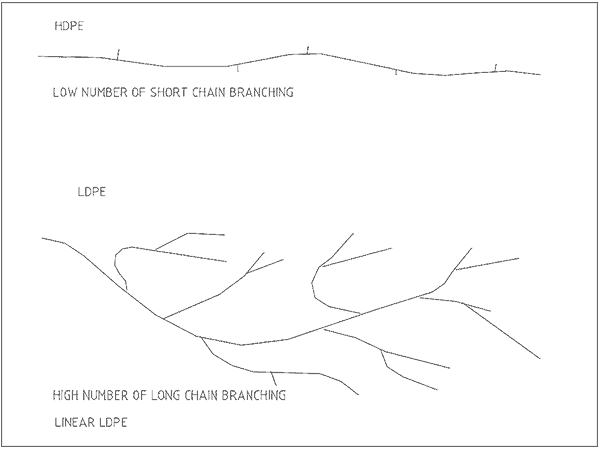Low Density Polyethylene (LDPE)
Table of Contents
What is LDPE
Low Density Polyethylene is a branch of polyethylene with a density of 0.910–0.940 g/cm3. What fundamentally separates LDPE from its HDPE counterpart, is the structure of their polymer chain. Despite both being constituted by ethylene monomers, LDPE possesses a polymer chain with side branches. There branches are responsible for LDPE's low density as they have an irregular shapes and causes gap in-between each polymer chains. LDPE have a melting point of 105-115°C [1].
Figure 1: Polymer chain of polyethylene [2] |
|---|
Advantages and Disadvantages
LDPE Advantages | LDPE Disadvantages |
|---|---|
|
|
LDPE Chemical Compatibilities
When not exposed to strong oxidizing agents, LDEP remains unreactive at room temperature. It is able to withstand a temperature of 80°C - 95°C under a short operation time. While the nature of LDPE being tough and flexible, it can still break under high pressure condition. Comparing to HDPE, LDPE shows lower tensile strength yet higher resilience [3].
.
Table of LDPE's chemical properties [3]
| Element | LDPE's corresponding resistance | Chemical reaction with LDPE |
|---|---|---|
| Acid | Excellent | None |
| Base | Excellent | None |
| Ester | Excellent | None |
Aldehydes | Good | Low |
| Ketones | Good | Low |
| Vegetable oil | Good | Low |
| Aliphatic | Limited | Significant |
| Aromatic | Limited | Significant |
| Hydrocarbons | Limited | Significant |
| Mineral oil | Limited | Significant |
| Oxidizing agent | Limited | Significant |
| Halogenated hydrocarbons | Poor | Violent |
LDPE Pipes Applications and Fitting
Common LDPE piping have a outer diameter ranging from 12mm to 75mm. with a maximum pressure of up to 10 bars. When compared to HDPE pipes, LDPE pipes are much smaller in size, therefore LDPE pipes are often used to transport solvents such as water in low quantities. It sees most frequently applications in: drainage, agriculture, gardening, and irrigation systems [4].
Some applicable methods of joining LDPE pipes[4]:
- Mechanical Connectors
- Inside Welding
- Electro Fusing
When fitting LDPE pipes, the inner diameter of the pipe is measured for the fitting.
Figure 2: A sizing chart of LDPE [5] |
|---|
LDPE Recycling
Despite both being polyethylene, LDPE must be recycled separately from its high density counterparts, giving it a recycling number of 4. Although it was not accepted for most recycling programs in the past, more communities starts to adopting the progress as LDPE is one of the most produced plastic. During recycling, processors melts down LDPE to eliminate its contaminants and then form them into thin resalable plastic sheets.
Figure 3: Recycling symbol of LDPE [6] |
|---|
Contributors:
| User | Last Update |
|---|---|
| Former user (Deleted) | 1129 days ago |
| Former user (Deleted) | 1130 days ago |
| Former user (Deleted) | 1158 days ago |
| Former user (Deleted) | 1172 days ago |
Faculty Advisor: Mary Robinson

